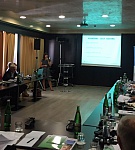This year’s yields topic at the round table organized by the Association Serbia Grains

On August 9, a round table discussion was held in Novi Sad on the current issues in the agricultural sector, namely the state of sunflower, soy, and maize and the quality of wheat from the crop of 2017, featuring a special topic on rapeseed as a promising culture. The conference was organized by the Association Serbia Grains with the support of UN FAO (Food and Agriculture Organization of the United Nations) and EBRD (European Bank for Reconstruction and Development) in the context of the project for the advancement of grain and oilseed export.
The round table saw the participation of Natalija Kurjak, Marketing Director of Victoria Logistic, member of Victoria Group. She gave an estimate of the areas seeded with spring crops based on field data according to which, approximately 900,000ha are covered with maize, approximately 250,000ha with soy, and approximately 230,000ha with sunflower. In her report on the current crop conditions, she pointed out that, in a year like this, the consequences of the improvised application of agrotechnical measures are particularly obvious, often causing the neighboring parcels with the same hybrids or varieties to look completely different. She emphasized that it is currently impossible to carry out a precise assessment of the yields, as the crop conditions on the fields vary widely, depending on the agricultural measures applied, quality of soil, and local unfavorable weather conditions.
Other presenters at the conference were Dmitry Prikhodko from the UN FAO Investment Center in Italy, Branimir Marić from SGS Srbija, and Ana Marjanović Jeromela and Milisav Stojaković from the Institute of Field and Vegetable Crops Novi Sad. The round table was attended by representatives of the Ministry of Agriculture, Forestry and Water Economy, as well as representatives of agricultural producers, processors, and exporters in the field of grains and oilseeds.
The conference was closed by Vukosav Saković, Chairman of the Association Serbia Grains, who presented the consequences of this year’s dry summer for the yields of the spring crops. “According to our estimation, the yield will be reduced by as much as 30 to 50 percent compared to last year. Generally speaking, the conclusion is that the sunflower crop is the closest to last year’s output, as the increase of the area of cultivated land compensates for the reduction in yields. Soy, as a sensitive culture, has suffered a considerable damage, as it is affected not only by the drought, but also by vermin and diseases, primarily mites. Consequently, a yield reduction from last year’s almost four tons per hectare to only two to two and a half tons this year can be expected. The greatest variations can be seen in the predictions of specialists regarding the maize crop. Optimists predict a crop of five tons per hectare, while pessimists expect a crop of less than two tons per hectare. However, let’s hope that the total maize yield will reach 4.5 million tons in the end”, stated Saković and added that, upon consultation with their members and agricultural experts, the Association Serbia Grains would submit a proposal to the responsible Ministry concerning the measures that might moderate the consequences of the reduction in yields affecting agricultural producers and the national economy.


